
Silicon Graphics and Real-time
Broadcast Graphics at the BBC
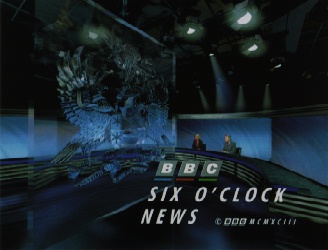


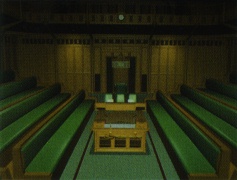 For the BBC, dedication to top quality programming includes a
commitment to creating a distinctive visual identity for all its news
and current affairs programmes. The BBC's Post Production Computer
Graphic Design Section uses Silicon Graphics equipment to create a
range of animation sequences within news bulletins - including the
1992 US Presidential Election coverage.
For the BBC, dedication to top quality programming includes a
commitment to creating a distinctive visual identity for all its news
and current affairs programmes. The BBC's Post Production Computer
Graphic Design Section uses Silicon Graphics equipment to create a
range of animation sequences within news bulletins - including the
1992 US Presidential Election coverage.
Computer special effects have become associated with big budget feature films such as The Hunt for Red October, The Abyss and Terminator II. Yet everyday news and current affairs programmes also depend on advanced computer graphics technology for their presentation of events. Highly skilled teams have made an art out of mixing complex images, sounds and words to present information in compelling formats. The key to success is that such effects should integrate seamlessly with the news presentation when broadcast. That is certainly the view of the Post Production Computer Graphic Design Section of the British Broadcasting Corporation's (BBC) News and Current Affairs (NCA) section, which uses high powered visual computing systems from Silicon Graphics to stay ahead in this crucial aspect of broadcasting.
The Computer Graphic Design Section acts as an internal facilities house within the BBC, providing a range of services to News and Current Affairs producers. In the summer of 1992, staff at the section won the coveted tender to work on the US Presidential Election coverage, and identified a need for more computer power to help prepare material for several hours of live television. The BBC turned to Silicon Graphics to meet that need.
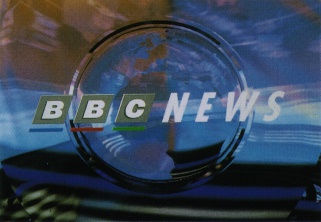 "We chose Silicon Graphics because virtually all the software we are
interested in runs on their systems," says Jerry dark, manager of the
NCA Post Production Computer Graphic Design Section. "One of the
beauties of Silicon Graphics hardware is that it's fast. Silicon
Graphics is at the top of the performance league and this is
important to us because everything we do has to excel in its visual
appeal." The early stages of the project involved months of
preparation for the presentation of computer graphics which would be
used in an eight hour programme giving live coverage of the US
election. The plan was to generate animated graphics to clarify
issues as they were discussed and illustrate the voting patterns for
different candidates as they emerged during the polls. A digital
model of the White House was also created so when the race for the
President's post needed illustrating, the camera could take the
viewer in and around the building."
"We chose Silicon Graphics because virtually all the software we are
interested in runs on their systems," says Jerry dark, manager of the
NCA Post Production Computer Graphic Design Section. "One of the
beauties of Silicon Graphics hardware is that it's fast. Silicon
Graphics is at the top of the performance league and this is
important to us because everything we do has to excel in its visual
appeal." The early stages of the project involved months of
preparation for the presentation of computer graphics which would be
used in an eight hour programme giving live coverage of the US
election. The plan was to generate animated graphics to clarify
issues as they were discussed and illustrate the voting patterns for
different candidates as they emerged during the polls. A digital
model of the White House was also created so when the race for the
President's post needed illustrating, the camera could take the
viewer in and around the building."
The plan was to use computer graphics to clarify the issues discussed on the programme and illustrate the voting patterns for different candidates as they emerge during the polls. As well as graphs and histograms, we also showed real-time animations over a rippling US flag. Along with the model of the White House, these effects helped to bring the race for the President's post to life," said Jerry Clark. "In broadcast graphics work, our task is simple but demanding. We have to generate graphics that look right first time. We don't want things to look technical for the sake of it, but they must look elegant. There is no second chance in live television - nothing waits for you," points out Clark.
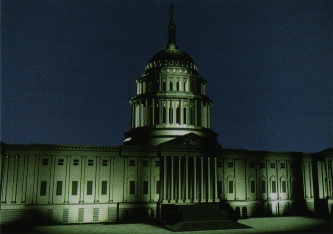 These background elements are then stored on a Sony CRV laserdisk
recorder which can hold up to 24 minutes of video at 30 frames per
second. The live animation from the Silicon Graphics systems appears
as an overlay on top of the background sequences. The result of the
BBC's creative expertise and this integrated hardware system was some
"spectacular animations", according to the BBC. For text items, a
Chryon real-time character generation system was used. Chryon has
adopted Silicon Graphics as its next generation hardware system and,
in addition to tiding, graphics modelling, paintbox and editing
functions are all available within a single Silicon Graphics
machine. An Abekas A66 and the Sony BVW 75 used for digital video
storage are controlled by Silicon Graphics systems and the computer
graphics section has written its own code for reading onto the video
devices.
These background elements are then stored on a Sony CRV laserdisk
recorder which can hold up to 24 minutes of video at 30 frames per
second. The live animation from the Silicon Graphics systems appears
as an overlay on top of the background sequences. The result of the
BBC's creative expertise and this integrated hardware system was some
"spectacular animations", according to the BBC. For text items, a
Chryon real-time character generation system was used. Chryon has
adopted Silicon Graphics as its next generation hardware system and,
in addition to tiding, graphics modelling, paintbox and editing
functions are all available within a single Silicon Graphics
machine. An Abekas A66 and the Sony BVW 75 used for digital video
storage are controlled by Silicon Graphics systems and the computer
graphics section has written its own code for reading onto the video
devices.
There is also a 400dpi Canon colour photocopier which takes GIF, TIFF and TAGA file formats, and the bureau Communication Arts produces 4000x4000 resolution rendered printed output on its inkjet printer for publicity and set backdrops. "The whole idea of using Silicon Graphics systems is to save money," explains Jerry dark. "As the quality of Silicon Graphics technology goes up, the price performance is getting better - making the systems even better value."
Animations are generated by the Silicon Graphics systems on a frame by frame basis, and one second of animation is made up of 25 frames. Clark explains that the animations are rendered frame by frame and then stored on the computer's hard disk or on another recording device such as the Abekas or Sony machines. When video frames are stored on these other recording devices, the frame is displayed on the computer's output frame buffer from which it can be recorded. "The computer puts a single frame on the video output buffer and then instructs the external device to record that frame at a particular place. The next frame is then displayed on the video output buffer and recorded next to the previous frame, and so on," explains Clark. "The completed animation is then fed into an editing suite via a video feed, or, if it is on Beta, the tape is taken to an editing suite for incorporation in the final broadcast sequence." Concept work for the graphics animations is carried out on paper from a brief put together by the producers of the programme. The producers also create a record of graphics and illustrations they want to run alongside their editorial scripts. A designer is assigned to work on the project, who after going through the record, designs the types of graphics to be used.
To save time, some engineers on Jerry dark's team at the BBC have written their own software for the POWERVISION systems, to help them render any scene in under a second. This alleviates some of the pressure the team is under, dark is also keen to develop a database of commonly used stills which will be driven by the Silicon Graphics computers.
"Title sequences and graphics work within programmes are crucial in creating identity and tone for a programme. Within the BBC, producers want state of the art 3D animations to help them achieve different effects. The challenge that faces us is to produce those sequences to a deadline. Silicon Graphics systems deliver technological capability in an accessible form for us to deliver top quality work on time."
Virtual studio and 3D graphics at BBC News
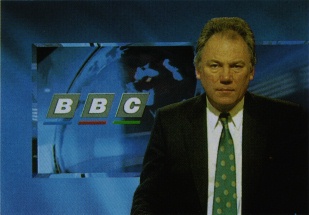 "BBC's news bulletins move into virtual reality," was the headline
from one national newspaper story on the Corporation's
computer-generated set that appeared on television for the first time
on 13th April 1993. The major facelift of news programmes on BBC
caught the public's imagination and led to widespread national media
coverage. The move is intended to make it clear instantly to viewers
that they are tuned to BBC bulletins and ensure that programmes have
a common theme.
"BBC's news bulletins move into virtual reality," was the headline
from one national newspaper story on the Corporation's
computer-generated set that appeared on television for the first time
on 13th April 1993. The major facelift of news programmes on BBC
caught the public's imagination and led to widespread national media
coverage. The move is intended to make it clear instantly to viewers
that they are tuned to BBC bulletins and ensure that programmes have
a common theme.
Since April 13th, all programmes, from Business Breakfast in the morning through to the Nine O'clock News in the evening, have featured new titles, a new set and new graphics. The title sequence opens with a re-designed news logo featuring a three dimensional cut-glass globe and the BBC's coat of arms. Both these elements have been generated on Silicon Graphics's systems by a team at the BBC.
A unique feature of the new look is the transition between virtual reality - images created using computers - and the real studio set. Another advance is the introduction of real-time three dimensional graphics into daily programmes. The BBC says that the way the Corporation is using the latest technology together with automation, wilt mean efficiencies and savings for BBC News. The whole project was conceived and designed in-house in BBC News and Current Affairs.
"The project's design team, led by Tim Goodchild, Don Harley aniMikeHSwkesworth, have been working at the leading edge of technology," says Tom Wragg, head of resources at the BBC. "Although the programme designs will have a common theme, they won't be identical. The titles will have significant variations on the theme and the music will be different."
HEAD OFFICE
Silicon Graphics Limited
Forum 1, Station Road, Theale, Reading
Berkshire RG7 4RA UK
Tel: (+44) 734 306222
Fax: (+44) 734 302550
MANCHESTER OFFICE
Silicon Graphics Limited
Laser House, Waterfront Quay,
Salford Quays, Manchester M5 2XW
Tel: (+44) 61 877 8801
Fax: (+44) 61 877 8343
SILICON GRAPHICS EXPRESS
on 0800 440 440 for fast product
information and pricing.
The Silicon Graphics logo, IRIS Indigo, POWERVISION and VideoLab are trademarks of Silicon Graphics Ltd. All other trademarks recognised.
Copyright 1993 Silicon Graphics Ltd. Written by Hunt Thompson. Designed and produced by The Concept Company Ltd.
